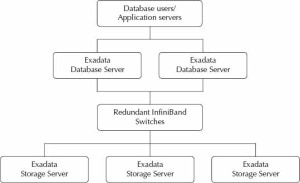Another type of engineered system is Oracle’s Exadata series of machines, which has been originally designed from the ground up to provide “extreme” performance and scalability for large data-warehousing, transaction-processing, and database consolidation workloads. This capability is delivered through a series of components, carefully chosen to integrate well together. Figure 1 shows the relationship between these components.
Let’s look at how these components work together to provide the best possible performance:
- Database servers Database servers are the components that will be most familiar to Oracle DBAs. They are enterprise-class servers that run Oracle Grid Infrastructure, Automatic Storage Management, and database software. The database instances run on database servers and receive connections from database users.
- Storage servers Exadata storage servers (also known as storage cells) are a component only found in Oracle-engineered systems. Like database servers, they run enterprise-class server hardware. But they also contain a large collection of hard drives that store actual database data, and flash-memory cards that provide low-latency data caching. Storage servers do not run database software, but instead run Exadata Storage Server Software, a set of software programs that manage I/O requests coming from database servers and asking for data to be returned to the user or process.
- InfiniBand networking Exadata’s internal networking is built on InfiniBand, which is a protocol designed for high-performance computing environments to deliver low-latency communications and extensive scalability. The InfiniBand infrastructure consists of InfiniBand interface cards in database and storage servers connected via fiber-optic cables to a set of InfiniBand switches. The switches are configured to allow the Exadata machine to continue running in case of a switch failure, and to permit multiple Exadata racks to be connected together into one large cluster. If you have other InfiniBand-capable equipment such as an Exalogic system, it can be connected directly to the InfiniBand switches for high-speed communication with the Exadata database machine.
- Management components A series of components is provided to allow hardware to be managed remotely, which is important when the Exadata database machine is located in a far-away datacenter facility. Components include integrated lights-out management (ILOM) controllers inside database and storage servers, a management-specific network switch, and network-accessible power distribution units. These components are designed to allow data access even when other components are inaccessible.
These components are bundled together in balanced configurations, intended to ensure that the processing capacity of each component is used efficiently while still maintaining high availability, so that any single component can fail while the overall system continues running. Configurations range from an eighth-rack up to a full rack with a full eight database servers and fourteen storage servers. Even larger configurations are possible by interconnecting multiple racks. It is also possible to add individual storage servers to an existing Exadata configuration, although care should be taken to ensure that the additional storage I/O volumes do not overwhelm the capacity of the database servers to process it.

Leave a Reply